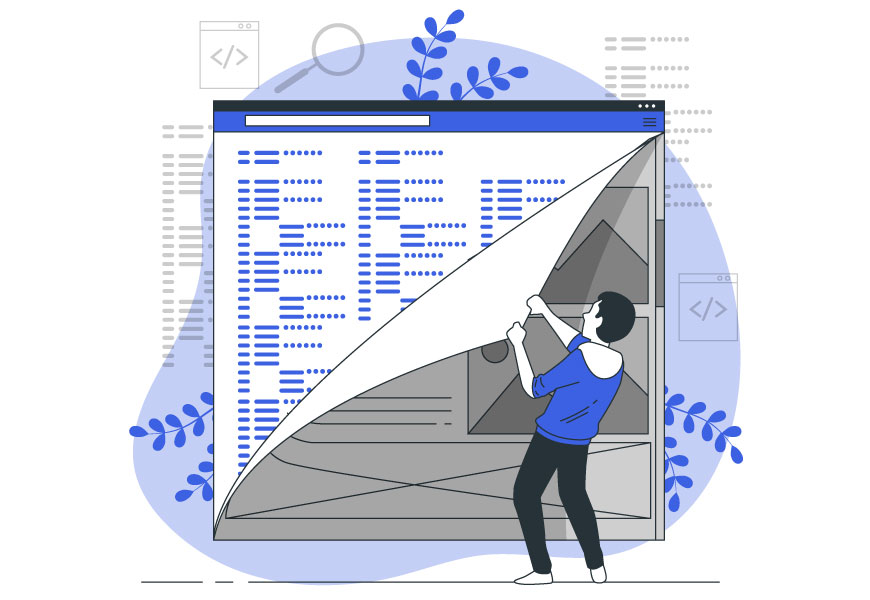share
Blockchain is trending now and gained mass adoption. But what is it, and how does it operate? Find out everything you need to know about this system, types, and accessible components.

What Is It?
It is quite obvious, but it is a database that stores ciphered blocks of data then chains them. This system was published 30 years ago by a team of experts, and it was designed to timestamp digital docs, so anyone is capable of antedating or editing them.
However, blockchain technology went mostly unused until it was adopted more than ten years ago to roll out the biggest virtual coin called BTC.
This is a distributed ledger that is fully accessible to all parties. It is important to note that once the info is integrated within a blockchain, members are not capable of editing it. Let’s discuss blocks and the way they operate.
Each block in a blockchain holds a piece of info, the hash of the block itself, and the hash of the prior unit. The data kept on a block depends on the kind of blockchain. For instance, a widely spread and prominent system is the Bitcoin blockchain and bitcoin blockchain architecture. It accumulates all the info about customers of a transfer and the number of assets.
Each block also has a hash, which is unique. A hash identifies the block and all of its contents and is always ‘outstanding’, just like a fingermark. Once a block is made, its hash is computed. Editing anything inside the block will cause the hash to variate. So, if the hash of a block changes, it is no longer the same element.
The third element inside each block is the hash of the previous unit. This effectively creates a chain of blocks, and it is this technique that makes a blockchain so safe and sound.
So, changing a single block will damage all the next blocks and make them ineffective. But using hashes is not enough to avoid counterfeits. Top-notch tech can calculate a huge amount of hashes per second. This means you can effectively tamper with a block and recalculate all the hashes of other blocks to make your blockchain valid again.
Blockchains implement proof of work in order to slow down the development of new blocks. In the case of the Bitcoin blockchain, it takes about ten minutes to calculate the needed proof of work and integrate a new block into the chain. This mechanism makes it counterfeit to tamper with blocks because if you edit one block, you will have to recalculate the proof of work for all the following blocks.
The safety of the system and blockchain architecture depends on the creative use of hashing and the proof of work mechanisms. In addition, it is spread.
Instead of having a single entity to monitor the chain, a blockchain uses a P2P network that anyone is allowed to enter (assuming the blockchain is public). When someone joins this blockchain network, they get a full copy of the system. This node can then use the copy of the blockchain to make sure that everything is correct.
Now let’s see if a new block can be integrated into a blockchain system. That new block is forwarded to all nodes on the network. Each node then verifies the block to make sure it is not fake. As soon as it was confirmed, each node took this block into its own blockchain structure. The nodes in the network eventually reach a consensus: they come to an agreement on which units are active and non-active.
Blocks that have been changed will be excluded by other nodes in the blockchain system. You will be unable to change it because you have to take more than half of the blockchain network under control.

What Does It Consist Of?
A blockchain is an open financial ledger or record in which every transaction is proved and authorized. A blockchain is developed as a decentralized network of millions of electronic machines, commonly referred to as nodes. It is a spread database architecture in which each part plays the role of a network administrator who voluntarily enters the ecosystem. There are no consolidated data, and it is constantly reviewed by users. So, hacks are unlikely.
Blockchain architecture supports a widening range of ordered records known as blocks. Each block has a timestamp, and it is attached to the previous element.
Components of a blockchain architecture
Here are the main components of a blockchain architecture:
Node — an electronic machine in the whole blockchain architecture (each node has an autonomous copy of the entire blockchain ledger)
Block — A sealed data compartment that contains:
- the hash code from the prior unit in the row of blocks
- a native hash code that recognizes the block
- a set of timestamped transactions
Transaction — A data record verified by participants that serve as an almost immutable confirmation of the authenticity of a financial transaction or smart contract
Miners — Nodes that validate blocks before adding them to the blockchain system
Chain — An order of units known as blocks
Consensus (protocol) — a set of regulations and agreements for executing blockchain transactions.

Types
Private
A private blockchain architecture provides only a certain group of members (organizations or people) to access materials. Such blockchain architectures are built by firms with the aim of increasing the overall benefit or efficiency. Their reliability is ensured by the common goals of the participants and proof of stake (PoS) and Byzantine fault tolerance (BFT) consensus algorithms.
A private blockchain architecture decouples the main blockchain protocol from the smart contract layer. Using a private blockchain, you can open up a programmable transaction area known as a smart contract, as well as online markets.
Public
A public blockchain architecture operates on the basis of proof of work (PoW) consensus algorithms and uses appropriate protocols. A public blockchain does not need any permission, as it is open-source. You can define new blocks with their existing state, as this is open-source. You can also download a blockchain’s code and check transactions on the network.
This makes transactions possible across the entire ecosystem. A public blockchain architecture provides transparent yet undisclosed or pseudonymous operations. The Ethereum, Bitcoin, as well as Litecoin blockchains are public.
Consortium
And last but not least, a consortium blockchain architecture. In this type of blockchain architecture, any participant can join and view it, but it is possible to change or add info only with the allowance of other parties. Such blockchains are utilized by firms to build loyalty among their clients. It is trustworthy due to the presence of trust among users and the same PoS and BFT consensus algorithms.
Depending on the type of blockchain structure and its context, this ecosystem can be more centralized or decentralized. This just belongs to the design of the blockchain architecture and who manages the blockchain ledger. A private blockchain is centralized, as it is ruled by a team with high privacy. On the contrary, a public version is open and spread.
In a public blockchain, all records are approachable for everyone, and anyone can take part in it. But this kind of blockchain is less efficient, as it takes a significant amount of time for each new record to be accepted in the blockchain architecture.
Regarding its performance and the time claimed to process each operation on a public blockchain, it is not eco-friendly too. The greatest processing power is mandatory in comparison to blockchain architecture.

Pros
Trustworthy
The traditional transaction process has a third-party participant like a banking house, payment platform or bank card. So, they charge an additional commission to process every transaction. The major advantage of Blockchain technology here is every transaction made is public. The overall cost is also reduced, and it offers consumers a rock-bottom commission.
The distributed network nodes of the blockchain technology verify every transaction stage and replace the need for a third-party interposition. The process where miners constantly verify all kinds of transactions 24/7 is called mining.
Thus, blockchain technology never fails to monitor transaction aspects and is almost impenetrable to cheat. Excluding intermediaries will lower the risks of relying on a single firm and lower costs too.
Instant Payments at Reduced Costs
The transfers done via blockchain are rapid but at a reduced overall cost. The traditional paper-heavy processes of transaction stages are effortlessly replaced by single record-keeping of blockchain. It is accomplished well with trustworthy dealings, even without third-party interference.
There is no place for hard paperwork, and transactions are processed smoothly and have almost zero flaws. Virtual assets help in streamlining processes quicker and at rock-bottom fees.
Stable
One of the major pros is its steadiness. Firms can rely on these systems that have higher retention in their services. Once data is downloaded in the digital ledger, you have no chance to exclude or edit it. So, it can be a great solution for a platform.
All the details saved on a blockchain are transparent and accessible by all participants. The accuracy and paperless ecosystem enable more transparency throughout the transaction process. It is also easy to track transfers made early.
There is no need to create multiple ledgers for different members. A single stable blockchain ledger is issued among the members with the least fraudulent activities.
No Place for Total Control
Blockchain technology can control key services managed by existing authorities more effectively. It can make, keep, and process data on every single operation at any moment.
Financial authorities, as well as the authorities, have no control over cryptocurrencies. And the main reason why is blockchain technology. As we know that authorities intervention has often led to the crash of fiat money, causing inflation or hyperinflation due to issuing too many fiat coins in a short period.
As the blockchain has no central government, authorities of different countries have no chance to take it under control or influence on crypto assets.
Improved Security and Greater Performance
Blockchain technology offers faster, more reliable transactions by eliminating third-party involvement, enhancing efficiency and streamlining processes.
People will be dependent on blockchains for not relying on a single firm for their entire process. Once a transaction is claimed, the system spreads the information to a wide set of open networks instead of a single place like in the traditional system of making transactions. This can prevent illicit activities and cybercrimes.

Cons
Alas, blockchain has several cons. As stated in the latest research, there are some kinds of attacks occurring in the industry nowadays. You should be aware of these issues, and here they are.
Problems With Private Key
Addresses are made up of individual private keys. That means that each participant has his or her private key to make these transactions. Encryption is connected with public-key blockchain and its processes. This public key address is shared with individuals where they receive access via their private keys.
If the person loses their private key, the process turns into a failure. They can do nothing to save their money or further transaction procedures.
It Is Not 100% Safe
We all know that blockchain offers maximum reliability and safety for its consumers. But it is important to note that it is not fully safeguarded, and they still face attacks frequently.
It is so crucial that the fraudsters can hack and grab control over the system. The security threat is sharpened by the latent nature of this bitcoin system. Anonymity is welcomed, but identifying scammers attempting illicit transactions is pretty hard, and it is a weak point of blockchain technology.
Scalability Problems
IT experts and other participants of the sphere note that BTC is the best coin to choose. That is why blockchain technology deserves attention. But we should highlight that it processes only seven operations in a matter of a second.
Regarding the scalability problems, it is crucial to say that the range of transactions in every node is limited. So, sometimes consumers face problems, and they have to wait to complete their transactions.
If we take blockchain’s transaction speed into consideration, widening the range of active participants is a bad idea. Ordinary banking procedures are rapid and more scalable in comparison to the blockchain.
Extremely Volatile
Altcoins that are utilized on blockchain technology are volatile. For instance, the wild ride of BTC. Its price changes every minute.
One of the reasons behind these wild price fluctuations is that assets, as well as decentralized blockchain technology, are novices in the financial segment. This means that the firms, authorities, and other groups have a chance to influence prices and cause severe fluctuations. These price ups and downs raise concerns among potential investors. So, it is hard for them to start using BTC or any other altcoin.
It Is Hard to Modify
In blockchain technology, it is hard to add or modify details as soon as they are recorded. It can be considered as a disadvantage too. The problem is that you need to change and rewrite codes to modify data. So, this process consumes a lot of time.
But it is crucial to say that a stable system is not as good as it is meant to be. So, irreversible records and complicated modification processes as the main characters of blockchain technology can cause a negative impact on the service.






